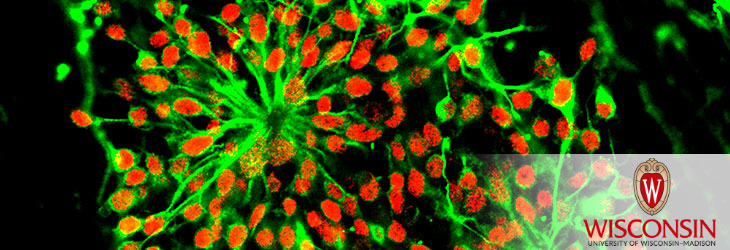Pluripotent Stem Cells

Generating Oligodendrocytes from Human Embryonic Stem Cells
WARF: P07394US
Inventors: Su-Chun Zhang, Baoyang Hu, Zhong-wei Du
The Wisconsin Alumni Research Foundation (WARF) is seeking commercial partners interested in developing a differentiation protocol to create myelinating oligodendrocyte cells.
Overview
Oligodendrocytes are a type of brain cell in the central nervous system that produces myelin, a fatty substance that wraps around and insulates neurons. These myelin ‘sheaths’ help conduct nerve impulses.
Oligodendrocytes can be generated readily from mouse embryonic stem cells. Applying the same method to human embryonic stem cells (hESCs), however, does not work. While several protocols have been published, none provide convincing evidence that the generated cells are able to produce myelin in vivo.
Oligodendrocytes can be generated readily from mouse embryonic stem cells. Applying the same method to human embryonic stem cells (hESCs), however, does not work. While several protocols have been published, none provide convincing evidence that the generated cells are able to produce myelin in vivo.
The Invention
UW–Madison researchers have developed a stepwise, chemically defined protocol for generating oligodendrocytes from hESCs. The process closely mimics that observed in a human embryo.
Firstly, the hESCs are differentiated to uniform neuroepithelial cells, followed by specification to Olig2-expressing neuron/oligodendrocyte precursor cells in the presence of sonic hedgehog protein or purmorphamine.
The precursor cells become mature oligodendrocytes in culture, and can produce myelin sheaths once transplanted into the brains of mice.
Firstly, the hESCs are differentiated to uniform neuroepithelial cells, followed by specification to Olig2-expressing neuron/oligodendrocyte precursor cells in the presence of sonic hedgehog protein or purmorphamine.
The precursor cells become mature oligodendrocytes in culture, and can produce myelin sheaths once transplanted into the brains of mice.
Applications
- Generating myelinating oligodendrocytes from hESCs
- Clinical usage and research
- May be useful for repairing injured brain/spinal cord, treating neurological diseases such as multiple sclerosis and various leukodystrophies
Key Benefits
- Stepwise, chemically defined protocol
- Efficient
- Generates cells that produce myelin in vivo
Additional Information
For More Information About the Inventors
Related Technologies
- WARF reference number P01258US describes a simple and efficient method for differentiating human embryonic stem cells into neural progenitor cells for pharmaceutical screening and potential transplant therapy.
- WARF reference number P04277US describes a method for in vitro differentiation of neural stem cells and neurons from human embryonic stem cells.
- WARF reference number P120289US02 describes a method for generating and expanding populations of neuronal subtype-specific progenitors differentiated from human pluripotent stem cells.
Related Intellectual Property
Publications
- Hu B-Y., Du Z-W. and Zhang S-C. 2009. Differentiation of Human Oligodendrocytes from Pluripotent Stem Cells. Nat Protoc. 4, 1614-1622.
Tech Fields
For current licensing status, please contact Andy DeTienne at [javascript protected email address] or 608-960-9857